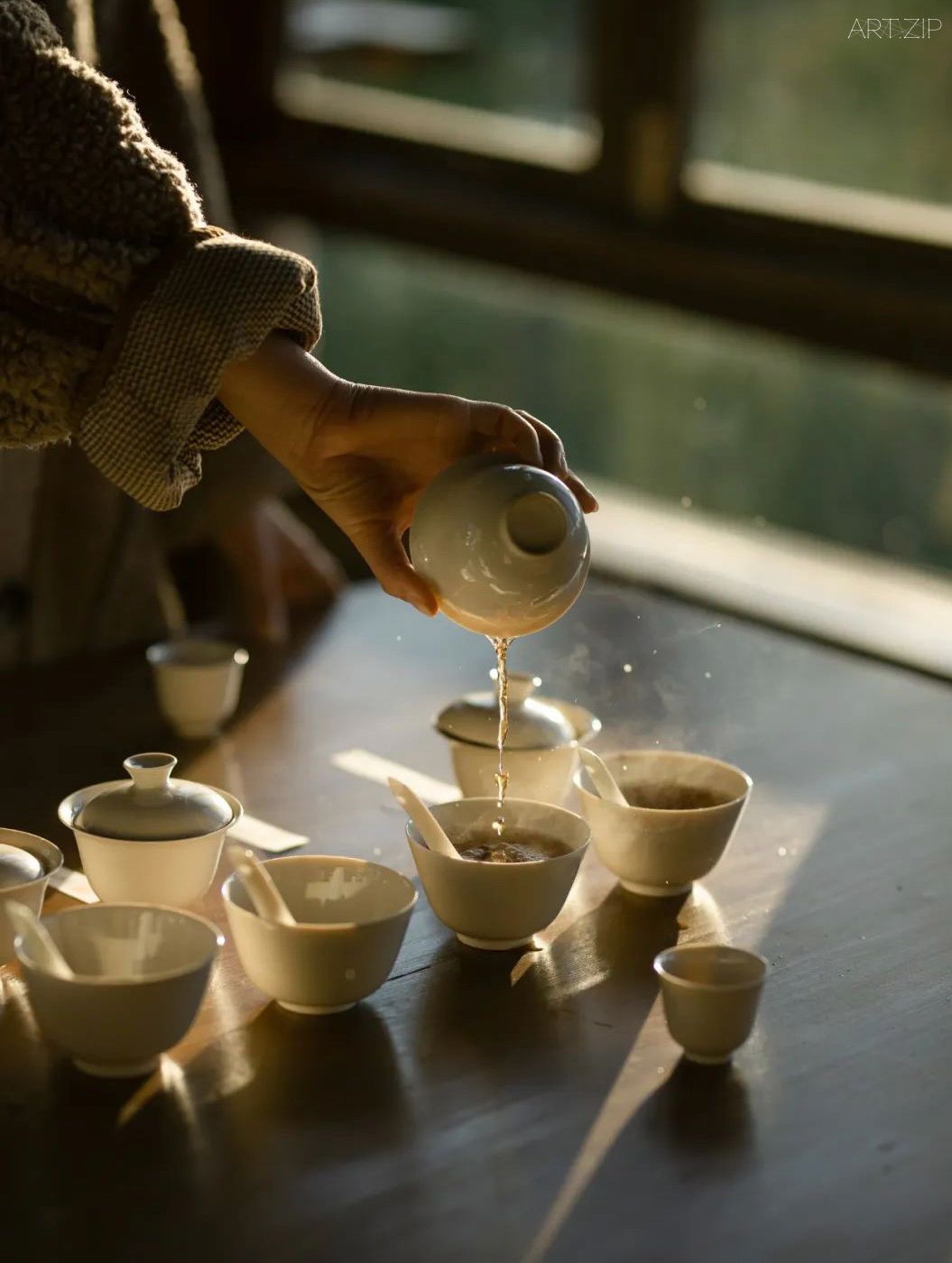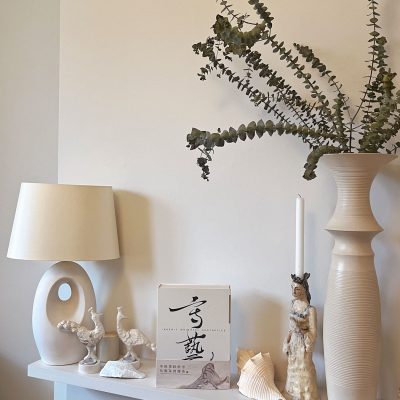
Marie (Li Ma) brought the hot, wetted leaves of the winter flower tea to her nose, and breathed in. Before a cup was handed to each of us in our circle, she motioned to a large, ceramic jar with geometric patterns in bands. She told us how those banded patterns represent flowers, and that the jar was produced by the Neolithic Yangshao culture.
So began a series of unique performances, held in intimate gallery settings around London. Through the techniques of poetic drama, storytelling, and the trained movements of an accomplished tea master, Marie Ma recontextualises the essence of the ancient Chinese tea ceremony for the modern day; and in so doing, she draws on modern methods to confront her audience with profoundly Chinese questions on the ephemeral and the eternal.
Tea was historically seen as an indispensable product in China, on a par with grain, oil, and salt, yet it was simultaneously the focus of spiritual and aesthetic admiration. In Marie’s performance work, the tea encompasses all these aspects, from the ‘earthy’ to the near-divine. They involve far more than merely the process of making the tea, or the stiff, elegant manner of preparation seen in classical tea ceremonies. Through her storytelling and the comparison of that winter flower tea with the Yangshao ceramic jar, Marie tells her guests how both tea and jar are the product of artisans capturing the essence of wild flowers. Both are material worked from the earth, both formed by hands, and both transformed from fluidity to permanence by firing at high temperatures.
For Marie, tea, the tea wares, artefacts, the ceremony, and her small audience are the media. To those who are unfamiliar with Chinese tea culture, it may not be immediately apparent that Marie is subtly adapting the standard forms. Typical contemporary tea shows in China adhere to a performance style that was developed during the 1970s for exhibitions and trade promotion. Such ‘Gongfucha’ practice, requires substantial skill, and is the segue during the conventional ceremony for a relatively lengthy discussion of the tea’s qualities, its cultivation and production methods. In all these cases, the focus is on the tea, and not on art more generally. In between, such shows can be relatively unstructured social events.
Marie’s performance practice subtly breaks these norms, and introduces the synergistic allusions arising between teas, poetry, and objects of contemplation into her work. Her performances express how tea is, and always has been, a soothing meditative aid under which simmers continual aesthetic, spiritual, and anthropological discourses. It is appropriate in her view that fuller stories are told, while leavening these with an acute attention to allusion and multisensory experiences.
Water is fluid in its movement, whilst the wares possess their brittle stillness, and tea binds these. Water and its freshness are crucial to tea and its quality. This was historically the case in China, where tea water was preferentially collected from white water rapids high in mountains. Marie stylisation of the ‘gongfucha’ method highlight this conceit: In the meeting of ware, tea, and water new spaces and movements are fleetingly created before they are lost in the narrative flow.
Marie also reworks the classical repertoire of preparation gestures that form the mainstay of the chinese tea ceremony, using moments of stillness, or the sudden draining of the wetted leaves as a prompt for contemplation, punctuating the narrative. Marie spends as much as 3 minutes in stillness and silence, allowing the murmur of the rolling water in the kettle to become audible. She thus recreates for her guests imagery and experiences which were recorded in the Song dynasty poems which she shares, “First with the autumn insect’s murmur, then came thousands of chariots carrying crops, finally when hearing about the sound of wind and streams among pines trees, one shall bring the bronze teapot away from the bamboo stool. When everything becomes silent again, we have prepared the water.”
Just as water and movement evoke the mood, the wares, especially the ceramics, are the prompts for Marie’s performative narrative. Marie’s background in the assessment and cataloguing of chinese ceramics has offers her a profound insight into the historical and tactile qualities of the small pots and beakers used to serve tea. Most of all, the tactility of the ‘gaiwan’ where the loose leaves are brewed, and the collection of cups in which the tea is poured. Her performance highlights the immediate symbolic qualities of ‘pure’ porcelain against rougher stonewares: their heat to the touch, and their sensitivity to hot water.
Marie’s particular interest is in dark, iron rich ‘jian’ ware bowls. On one hand these are a prompt to tell the story of how powdered green teas were whisked and served like matcha in Southern Song (c. 12th century) China; but outside of the cultural exposition, Marie tells stories of their unique hare’s fur like properties, and how these bring to mind river silt drifting over dark earth. She will tell her own experience of a small town in Fujian where these wares were traditionally produced. There the soil of the nearby hills is full of shards of ancient jian wares. In this, Marie explores the brittleness and permanence of ceramic shards in contrast to the elusiveness of the perfect brewing water.
Marie has notably conducted a seven-part live storytelling performance, taking the Tang dynasty poem ‘The Seven Bowls of Tea’ by Lu Tong (written 795 AD) as its starting point. The poem itself relates the poet’s change of spiritual awareness whilst drinking of seven cups of tea. The last cup brings Lu Tong riding through the clouds to an immortal mountain.
The gallery setting (W. SHANSHAN Gallery in St. James, London) on the 26th Mar 2023 was ideally suited to the project. It specialises in early Asian art artefacts, and their capacity to enhance contemporary settings. Over the course of the performance, Marie introduced six ancient Chinese artefacts that were made around the time the poem was written, before revealing a final contemporary tea set made of in rough brown stoneware which represented the immortal mountain. Each piece served as a metaphorical aid for the interpretation of the poem and the appreciation of each cup of tea that was served.
Marie frequently explores differing conceptions of femininity in her work. In the ‘Seven Cups’ repertoire, she contrasts two highly stylised Chinese tomb figurines with two teas.
The first of these depicts a slender, severe looking dancer from the Han dynasty with a black tea called ‘zhengshan xiaozhong’ (Lapsang Souchong) which has a pine-like smoky aroma. The second is a stouter, sweeter looking figurine from the Tang dynasty, with a large flower in her raised hairstyle. She is paired with another black tea, ‘miru hong’, which has a sweet, almost honeyed aroma, as the Chinese name suggests.
In telling the story of each of these — how they were intended to be kept permanently in a tomb, yet both capture a very special, ephemeral beauty in their form. With their chosen tea and the aromas, Marie makes a space for each figurine and makes an effective appeal for an uncomplicated appreciation of them and their beauty.
Marie’s work is a unique experience, the combined used of many traditional art forms in China are skilfully woven into a narrative that offers a fresh perspective of the sensory qualities of history, and the interplay of cultures. The use of ancient artefacts, and their introduction with a strange sense of irreverence and exactitude, sets the scene for many meditations on the nature of fluid imagination against brittle history, the difference between material and essence of the stories we create in our own lives. In her conception therefore, lived art is the only way to reconcile these disjunctures between permanence and impermanence, and to confront her audience with an intuition of a Chinese ways to address these.
Yet this may overstate the introspection in Marie’s art. She sees the tea trade as living practice as much as it is an art, and in her conversation, reveals a profound interest in the boundaries of ‘art’, ‘craft’ and ‘trade’. According to Marie, tea is, and should be a lived experience and practice with which performance and artistry can powerfully synergise. She plays with the role of artist and artisan. In Marie’s outlook, the poet, the exhibitioner, and the salesperson have to coexist, as otherwise it would not be true to her interest.
Tea was historically seen as an indispensable product in China, on a par with grain, oil, and salt, yet it was simultaneously the focus of spiritual and aesthetic admiration. Thousands of unique teas are produced in China. Each product brings with it a story: the place it was grown, its grower, its tea maker, its trade history, and its appreciation by tea connoisseurs from the deep past to the present. Many of the forms and aesthetic principles surrounding tea are the result of tea’s near continuous cross cultural trade after it became ubiquitous in China. Accordingly, Marie is seeking to bring better quality Chinese teas into Britain. Not only are these materials for performance, but a means to attain novel stories.
Between continued one-off performances over the intervening months, leading up to the upcoming exhibition, ‘Le Rouge et le Noir’ at Gallery Bookstore IMPRESSIONS in Paris (13th June 2024), Marie has developed a narrative which surpasses her media. She considers the essence of her tea ceremony to be akin to the practice of live poetry or storytelling. Each tea and teaware that is presented in the tea ceremony is bestowed with a hidden life and voice by the craftsman and the tea master. Marie succeeds in letting them meet.
带着当季腊梅花香的热气缓缓上升,我们秉着呼吸,看着麻利将轻薄的茶杯送至胸前,轻轻地吸了一口气。在把小瓷杯递给我们圈子里的每个人之前,她指向一个带有几何图案的大陶罐。她告诉我们这些带状图案是如何代表花朵的,以及这个陶罐来自遥远的新石器时代中国的仰韶文化。
于是,一系列独特的表演开始了,这些表演在伦敦各地私密的画廊环境中举行。通过诗剧、讲故事的技巧,以及一位技艺高超的茶艺大师训练有素的动作,麻利将中国古代茶道的精髓重新融入现代的背景中;在此过程中,她利用现代方法向观众提出关于短暂和永恒的深刻的中国问题。
茶在历史上被视为与粮、油、盐齐名的中国不可或缺的产品,同时也是精神、宗教以及审美崇拜的焦点。在麻利的表演作品中,茶涵盖了所有这些方面,从“朴实”到近乎神圣。它们涉及的不仅仅是泡茶的过程,或者传统茶道中附有程式、古典且优雅的准备方式。通过讲故事(腊梅花茶与仰韶陶瓷罐的艺术比较),麻利向客人们讲述了茶和陶罐皆是匠人从自然,从野花中受到灵感启发后的带有个人感情的产物,两者都是从泥土中提取的材料,由手塑形,并通过高温烧制,从流动性转变为永久性。
对于麻利来说,茶、茶具、古代及现代的手工艺品、茶道仪式和茶客都是媒介。对于那些不熟悉中国茶文化的人来说,可能不会立即看出她正在巧妙地创新当代茶艺表演标准程式。中国典型的当代茶艺表演延续了20世纪70年代为展览和贸易推广而发展起来的表演风格。这种“功夫茶”的练习需要很高的技巧,并且是传统仪式中对茶的品质、栽培和生产方法进行相对较长的讨论的延续。在所有这些情况下,焦点都集中在茶上,而不是更广泛的艺术上。在这两者之间,此类节目可以是相对无组织的社交活动。
麻利的茶艺表演巧妙地打破了这些规范,并将茶、诗歌和冥想对象之间产生的协同作用引入到她的作品中。她的表演表达了茶室是一个静思默想的空间,茶不断地酝酿着美学、精神和人类学的话语。在她看来,讲述更完整的关于茶叶的故事需要对意象暗示和多感官体验给予敏锐的关注。
水是流动的,而器物却是处于脆弱的静止状态,而茶则将它们结合在一起。自古以来,水及其新鲜度对于茶叶及其品质至关重要。中国历史上,泡茶的水会优先从高山的急流中收集。麻利对“功夫茶”方法的风格化强调了这一理念:在器皿、茶和水的相遇中,新的空间和动作在消失在叙事流中之前短暂地被创造出来。
麻利还重新设计了构成中国茶道中的经典程式:她利用备水时静止的时刻及盖碗的骤然倒水分别作为沉思的提示,以及为叙述打上断点。我们和她一起在三分钟的时间内,安静地聆听壶中水流的潺潺声。这一切再现了宋诗中记载的意象和经历,她分享道:水初沸时,如砌虫声卿卿万蝉鸣;忽有千车稛载而至,则是二沸;听得松风并涧水,即为三沸。此时需要把铜茶壶从竹架上取下。当一切再次安静下来时,我们就已经准备好了水。
正如水和运动可以唤起情绪一样,器皿,尤其是陶瓷,是麻利表演性叙事的提示。麻利在中国陶瓷评估和编目方面的背景使她对泡茶用的小壶和烧杯的历史和触觉品质有深刻的了解。最重要的是,冲泡散茶的盖碗的触感,以及倒茶的杯子的集合。她的表演突出了瓷器相对于粗陶的直接象征性品质:它们的触感温度,以及对热水的敏感性。
玛丽对深色、富含铁质的建盏特别感兴趣。她讲述了中国南宋(约12世纪)龙团凤饼与点茶技艺的历史故事;也讲述了这些器物上独特的由铁离子产生的的兔毫纹鉴赏方法,以及这些特性如何让人想起在黑暗的土地上漂流的河流淤泥。她讲述了她在生产建盏的小镇,福建建阳的亲身经历。附近山上的土壤里满是古建盏的碎片。通过展示建盏碎片以及邀请客人品尝在建盏中的茶以及在白瓷杯中的茶的区别,麻利探索了陶瓷碎片的脆性和持久性,与茶水的难以捉摸的鲜明对比。
麻利以卢仝的唐诗《七碗茶诗》(公元795年)为起点,进行了一场七段的现场叙事表演。这首诗本身讲述了诗人在品茗七碗茶时精神意识的变化。在品尝最后一碗茶汤之时,作者卢仝飘飘然乘云,去往长生不老的蓬莱仙山。
专注于早期亚洲艺术品及其与当代环境交互,位于伦敦圣詹姆斯的 W. SHANSHAN 画廊便非常适合该项目。在表演过程中,麻利介绍了在卢仝诗歌创作期间前后几个世纪中制作的六件中国古代文物,最后展示了最后一套用粗糙的棕色石器制成的代表蓬莱山的当代茶具。每一件器物都起到了赏析这首诗和赏析每杯茶的重要的隐喻性帮助。
麻利在她的作品中经常探索不同的女性气质概念。在《蓬莱几里,七茶七器》的剧目中,她将两个高度风格化的中国墓葬雕像与两种茶进行了对比。
其中第一个塑像描绘了一位身材修长、表情严肃的汉代女性舞者,她与一种名为正山小种的红茶进行搭配,这种茶具有松树般的烟熏香气。第二个是唐代的雕像,造型更粗壮、更甜美,高耸的发型上有一朵大花。她与另一种红茶,蜜乳红搭配,正如中文名称所示,它具有甜甜的、近乎蜂蜜的香气。
在讲述它们的故事时——它们是如何被永久保存在坟墓中的,但它们的形式都捕捉到了一种非常特殊、短暂的美丽。玛丽通过他们选择的茶和香气,为每个雕像创造了一个空间,并有效地启发了人们对它们的关注与思考。
参加麻利的茶会是一次独特且愉快的体验,她巧妙地结合了中国的许多传统艺术形式,融入了当代的叙事,为历史的感官品质和文化的相互作用提供了全新的视角。在表演中对古代器物的排列和使用,以及对它们带有个人情感的介绍,为许多思考奠定了基础:流动的想象力与脆弱的历史的本质,以及我们在自己的生活中创造的故事的材料和本质之间的差异。
然而,这可能夸大了麻利艺术中的内省。她将茶艺视为一种生活实践,也是一门艺术,在她的谈话中,流露出对“艺术”、“工艺”和“贸易”界限的浓厚兴趣。麻利认为,茶是而且应该是一种生活体验和实践,表演和艺术可以与茶产生强有力的协同作用。她扮演着艺术家和匠人的角色。在麻利看来,诗人、展览者和茶馆主理人必须共存。
茶在历史上被视为与粮、油、盐齐名的中国不可或缺的产品,同时也是精神和审美崇拜的焦点。中国生产了数千种独特的茶叶。每件产品都带有一个故事:它的种植地、种植者、制茶者、贸易历史以及从古至今茶鉴赏家的欣赏。茶的许多形式和美学原则都是茶在中国普及后近乎持续的跨各地域文化贸易的结果。因此,麻利正在寻求将更优质的中国茶引入英国,这些不仅是表演的材料,也是获得新奇故事的一种方式。
在巴黎印象画廊书店即将举办的展览“Le Rouge et le Noir”(2024 年 6 月 13 日)之前,麻利不断进行即兴表演,期间她发展了一种超越她本人的媒体的叙事。她认为茶道的本质类似于现场诗歌或讲故事的实践。茶道中呈现的每一件茶和茶具,都被工匠和茶师赋予了隐藏的生命和声音。而麻利创造了让他们邂逅的场景。
Edited by Rinka Fan
Posted on 16 April 2024



















